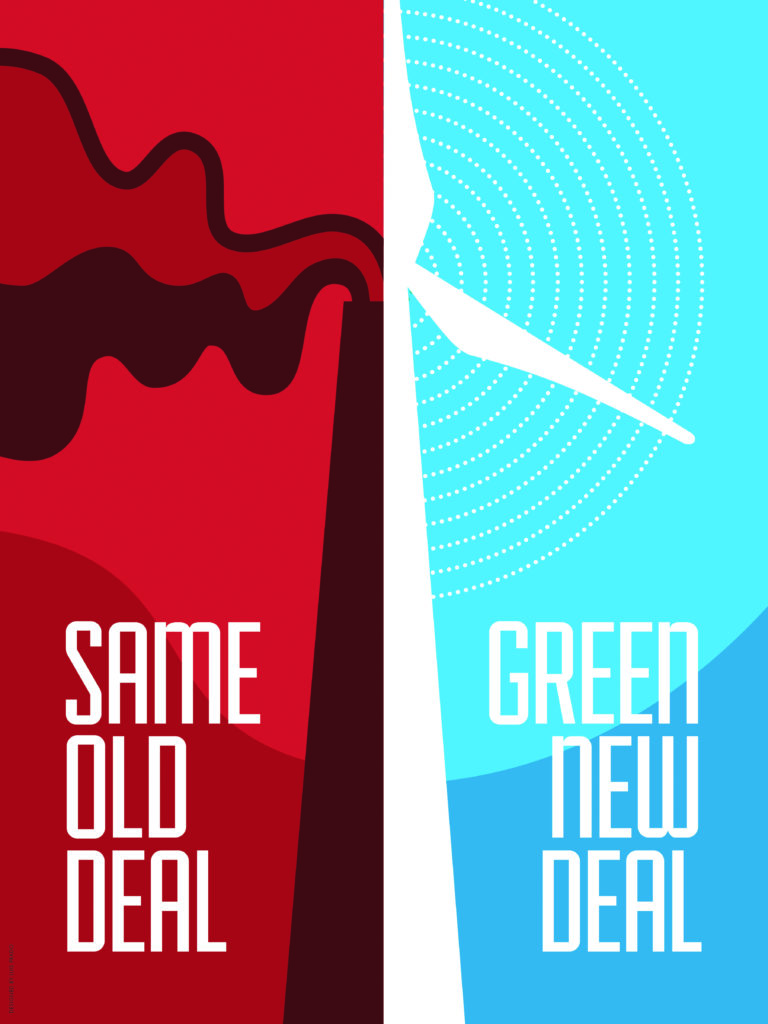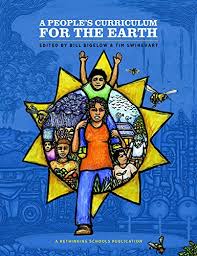Teaching the Green New Deal: The Prequel
Illustrator: Luis Prado / Creative Action Network

In an article introducing the student-friendly short video, A Message from the Future, about life after the Green New Deal, Naomi Klein points out:
Almost every vision of the future that we get from best-selling novels and big-budget Hollywood films takes some kind of ecological and social apocalypse for granted. It’s almost as if we have collectively stopped believing that the future is going to happen, let alone that it could be better, in many ways, than the present.
This coming dystopia seems to be prefigured in our students’ own lives: the pandemic and police violence, the forest fires that engulfed the entire West Coast last fall, the extraordinary cold snap that recently devastated the southern United States, and so much more. But as we know, these scenarios of a miserable future will not necessarily motivate our students to action — in the classroom or in the world.
As the five of us reviewed the Rethinking Schools book A People’s Curriculum for the Earth, toward assembling a second edition, we knew that we wanted more activities that would energize students not only by the harm that must be prevented, but by the beautiful possibilities on the carbon-free horizon, the kind of future expressed in the ambitions of the Green New Deal. Of course, the Green New Deal is not a single policy or even a platform, but a still-developing vision of transformation. We want students to be engaged as architects of that vision, not just observers — to make judgments about, and share opinions on, the collection of policies needed to prevent climate disaster and secure a more just future.
Yes, the GND is ambitious. That makes it easy for protectors of the status quo to dismiss it as impractical, impossible, pie-in-the-sky. Without concrete historical parallels to refer to, we worried that our students’ imaginations would fall prey to cynicism or defeatism. So we decided to begin a suite of lessons on the Green New Deal at the obvious place: the original New Deal, from which the GND, of course, takes its name and inspiration. It was in Franklin D. Roosevelt’s 1933 inaugural address that he accurately described what the people, experiencing the emergency of the Great Depression, expected from his administration: “action and action now.”
In a draft of a new lesson we wrote — posted at the Zinn Education Project’s “Teach Climate Justice” site — students learn about the ambitious and multifaceted plan of “action and action now” through the stories of a wide variety of everyday people who interacted with New Deal policies. Students meet:
• Viola B. Muse, hired as part of the “Negro Unit” of the Federal Writers Project to document the stories of the last living formerly enslaved people in Florida;
• Martina Curl, an artist hired to paint murals around Oregon by the Federal Arts Project;
• Fred Ross, hired by the Farm Security Administration to manage a camp in California for migrant workers fleeing the dust bowl and unemployment;
• James Lowe, hired by the Civilian Conservation Corps to do forestry work in rural Pennsylvania;
• Emma Tiller, a sharecropper in Texas who benefitted from the Works Project Administration’s jobs program even while criticizing FDR’s agricultural policies;
• And 13 more.
The role for Martina Curl, for example, describes her growing up in a family of migrant farmworkers in the Northwest, doing back-breaking work picking fruit from when she was 8 years old. But “the trees, the animals, the people — they all enchanted me.”
The beauty of the natural world never left me, and I fell in love with painting and drawing. I wanted to earn my living doing what I loved, and spent years after high school working and saving to attend Museum Art School. When I arrived, I felt out of place. My peers were wealthy and spent summers painting landscapes on luxurious vacations while I was picking fruit with my mother from sun-up to sun-down. Four years of working nights, weekends, and summers to support my education wore me down and, ultimately, prevented me from finishing school. I felt depleted and discouraged — sure that I would never be able to support myself and my son with art.
It’s only when the New Deal’s Federal Arts Project came along that Curl could combine her socialist politics and her love of art:
From 1936 to 1942, I received a $90-a-month stipend to create paintings and murals around Oregon. The Federal Arts Program exemplified the world we were fighting for: one of economic equality, beauty, and justice.
As students take on the personas of people whose lives were touched by New Deal policies, they meet each other in a mixer. They find people who benefited from a New Deal program, who experienced some kind of racial or gender discrimination, who were able to help others because of one of these programs, who, like Martina Curl, were able to do cultural work, whose lives were transformed.
We hoped these glimpses of the New Deal would equip our students, when it came time to talk about the Green New Deal, with historical encouragement to dream big and with plenty of practical ideas about how to transform those dreams into policies. The lesson asks them to step out of their roles to reflect on what can be learned from the original New Deal for a Green New Deal today — one that would focus on jobs, infrastructure, racial justice, fighting climate change, and addressing other pressing environmental issues.
Our activity on the New Deal is not meant to hold up the 1930s as a “When America Was Great” moment. We are clear-eyed about the New Deal: Its housing policies exacerbated and deepened segregation and the racial wealth gap; many of its provisions left out agricultural or domestic workers and, therefore, the majority of Black workers in the United States; although the Indian Reorganization Act halted some of the government’s most genocidal policies toward Native peoples, many other projects — like dam-building — ignored treaties and destroyed ways of life; and it was during the New Deal that the Roosevelt administration oversaw the mass deportation of hundreds of thousands of Mexicans and Mexican Americans. The New Deal, like the country from which it sprang, was poisoned by white supremacy. A number of characters in the mixer speak to their exclusion from New Deal programs or about its shortcomings. As Saikot Chakrabarti, Alexandra Ocasio-Cortez’s former chief of staff, put it succinctly, the New Deal “threw Black and Brown people under the bus.”
And yet. The New Deal was a time when the people of the United States demanded the government respond to their needs and suffering. It was a time when the government did respond — quickly and tangibly — to the emergency of the moment. And it was a period that some truly progressive ideas were given a chance — if only briefly — to take flight. Back to Naomi Klein, who argues that despite its significant limitations: The New Deal “remains a useful touchstone for showing how every sector of life, from forestry to education to arts to housing to electrification, can be transformed under the umbrella of a single, society-wide mission.”
A Green New Deal is possible and, indeed, in some respects is already underway. We can help our students recognize that the Green New Deal is not the only big and righteous idea dismissed as impossible even as it was already coming into fruition. When the immediate emancipation of four million enslaved people seemed like a remote possibility, enslaved people were already freeing themselves, they and their allies were already conducting the Underground Railroad, and abolitionists were already taking every possible opportunity to make slavery untenable, to create the crisis that would serve as an opportunity for lasting change.
That is what we hope to communicate to our students: We make the impossible possible by acting, by organizing, by doing. The example of the New Deal can help students imagine — and then enact — a bridge over the gaping chasm between an unsustainable now and a habitable and humane future.
The lesson described in this article can be found at www.zinnedproject.org/materials/new-deal-to-green-new-deal
Suzanna Kassouf (suzannakassouf@gmail.com) teaches at Grant High School in Portland, Oregon. Matt Reed (mreed217@gmail.com) teaches at Lincoln High School in Portland, Oregon. Tim Swinehart (timswinehart@gmail.com) teaches at Lincoln High School in Portland, Oregon. Ursula Wolfe-Rocca (ursulawolfe@gmail.com) is a Rethinking Schools editor and curriculum writer/organizer with the Zinn Education Project. Bill Bigelow (bbpdx@aol.com) is the Rethinking Schools curriculum editor.

